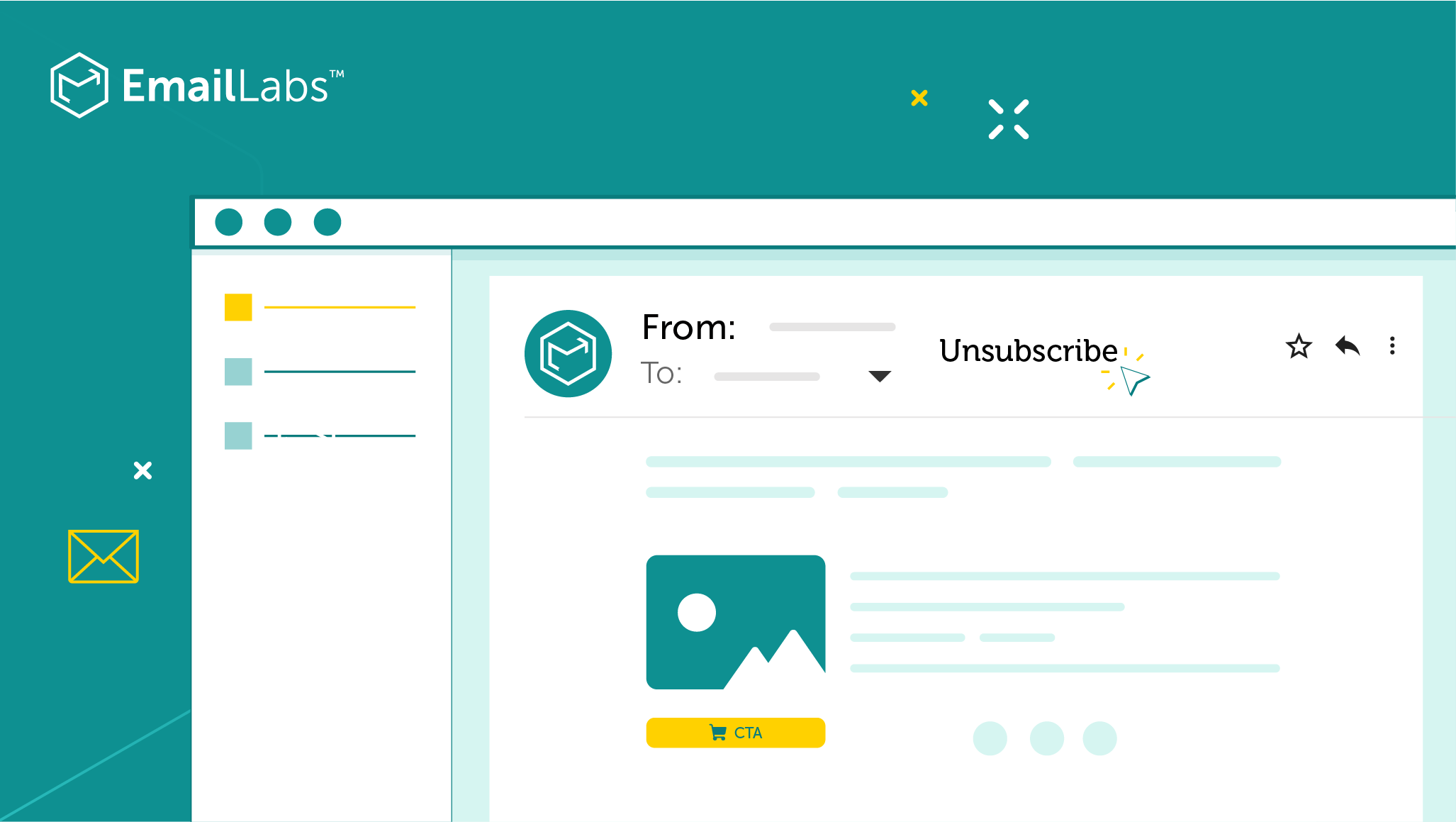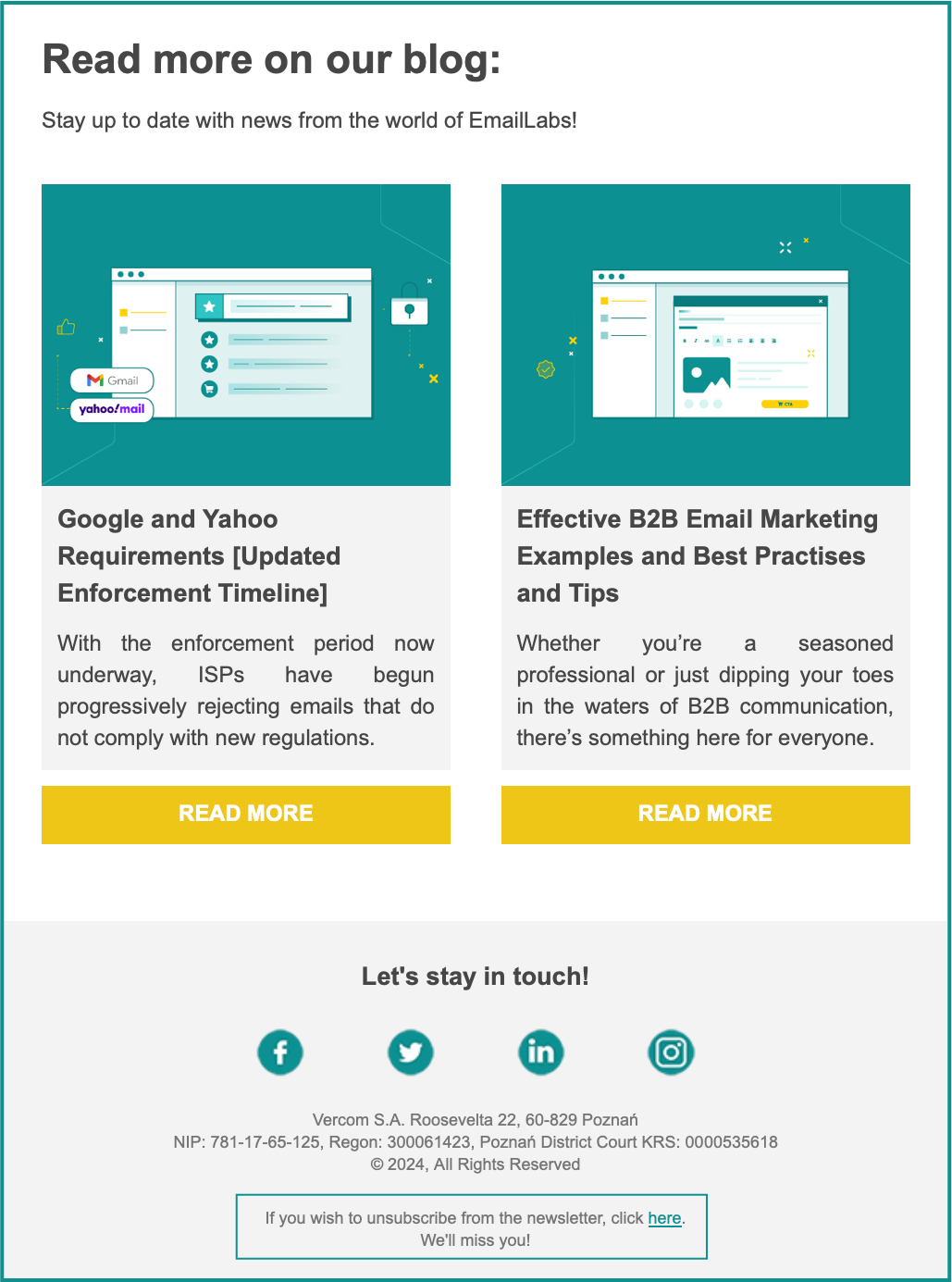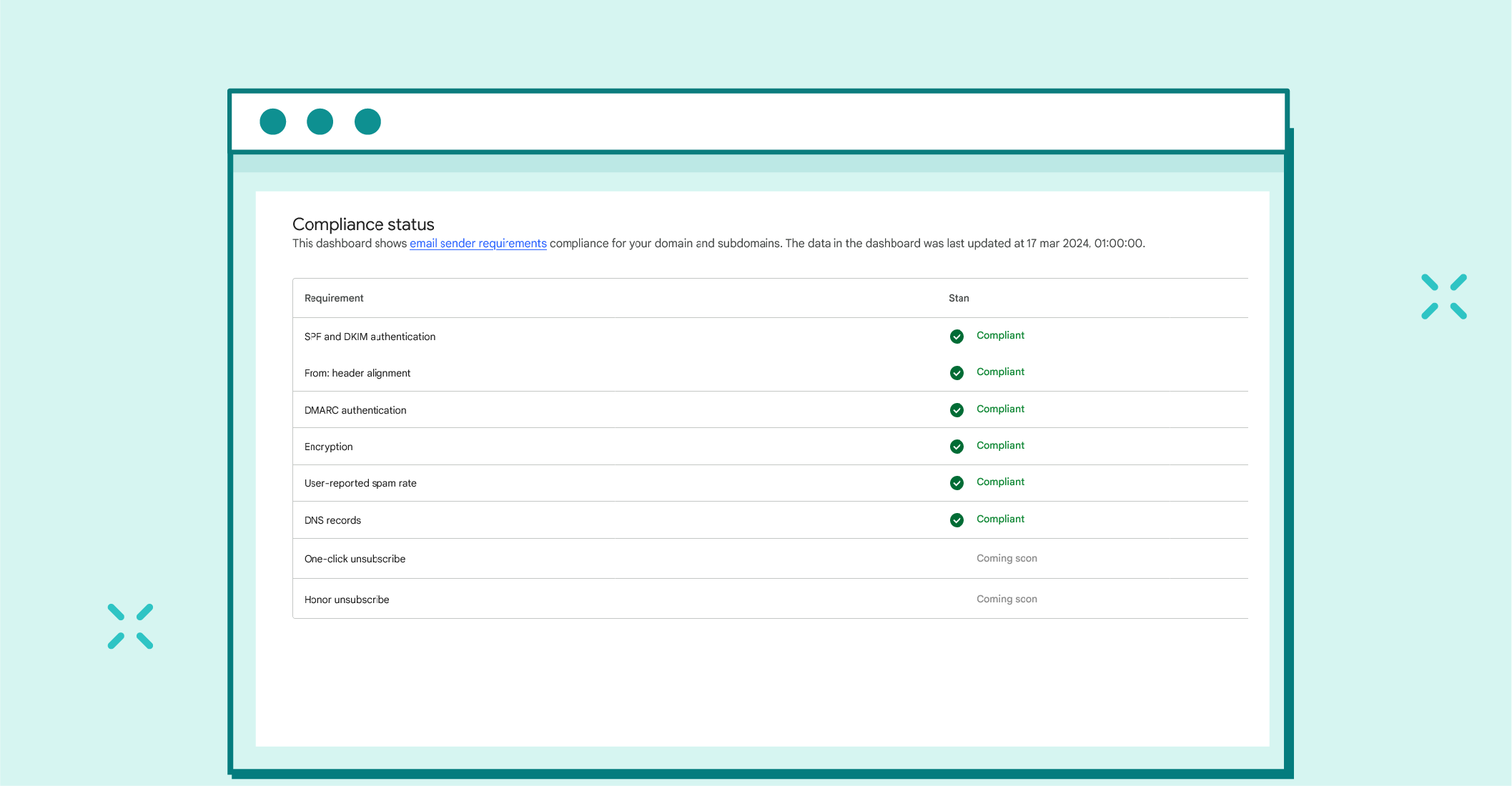Best practices, Dobre praktyki, Yahoogle
Best practices, Dobre praktyki, Yahoogle

If you’ve been following our updates, you’re likely aware of the recent changes in email sender requirements introduced by major global providers like Gmail and Yahoo.
As of February 1, 2024, a significant change has come into effect. The providers announced that bulk senders (sending over 5,000 emails) must have basic authentication implemented, such as SPF, DKIM, and DMARC. This new requirement applies to both marketing and transactional emails.
If you haven’t set up SPF, DKIM, and DMARC records yet, don’t delay—authorize your domain now using the free EmailLabs configurator!
A few months later, on June 1, ISPs began enforcing another modification, this time targeting only marketing email senders.
As of that date, implementing a one-click unsubscribe button, which allows users to easily opt-out of marketing communications with a single click, has become mandatory. The goal is to enhance recipient security and spam protection.
Google and Yahoo’s Email Sender Requirements in 2024 [Updated Enforcement Timeline]
In this article, we’ll guide you through the process of implementing one-click unsubscribe following RFC 8058, ensuring the best possible deliverability for your marketing communications.
As a sender of marketing communications, it’s crucial to ensure that the unsubscribe process is simple and seamless for recipients. The traditional method often involves multiple steps that users must complete before successfully unsubscribing from a mailing list.
Typically, users need to scroll to the bottom of the email, and find a small and often inconspicuous “unsubscribe” link. After clicking it, they are directed to a webpage where they may not always immediately have the option to opt-out of the mailing list.

An example of a traditional opt-in method in the form of a link placed in the footer.
Often, instead of a simple opt-out confirmation, users are required to log into their account, complete a survey, or undergo verification. This entire process, which doesn’t always result in a successful unsubscribe, can generate a lot of negative emotions in users, including frustration.
If users cannot unsubscribe simply, they often resort to marking the email as spam, which directly impacts your sender reputation.
One-click unsubscribe simplifies this process to the absolute minimum. Unsubscribing from a newsletter becomes much quicker, easy, and user-friendly. According to the new guidelines, all unsubscribe requests should be honored within a maximum of two days.
By implementing this feature, senders show respect and trust towards their recipients. It also helps protect their privacy by giving them greater control over their inbox.
Implementing a one-click unsubscribe feature shows that you, as the sender, value clear and transparent communication based on trust. It means that you respect your recipients’ time and privacy, allowing them to make decisions easily. This, in turn, enhances your reputation as a sender who values and respects your recipients.
Additionally, email users can quickly opt out of marketing communications by clicking a button at the top of the email. This not only reduces the likelihood of messages being marked as spam but also decreases the chances of them being deleted without being read.
By offering a straightforward unsubscribe option, your sender reputation remains intact, as it helps prevent a high rate of spam complaints and maintains engagement with your email content.
Maximize your email deliverability and security with EmailLabs!
Another significant benefit of implementing the one-click unsubscribe option is maintaining better hygiene of your email list. By regularly updating your recipient list to remove addresses that opt out, you build a more engaged and genuinely interested audience. Those who remain in your list are more likely to open and interact with your emails.
Last but not least, is compliance with provider requirements. Adhering to their guidelines is crucial and can directly affect your deliverability and message classification.
How to Prepare for Gmail and Yahoo! Sender Requirements Before February 2024?
The one-click unsubscribe feature is directly integrated into the email interface, allowing subscribers to instantly opt out of mailing lists. This makes the unsubscribe process easy and quick for users.
ISPs highly recommend using the RFC 8058 method, which involves implementing a functional list-unsubscribe header for marketing emails. While additional unsubscribe options like URL links in the message body are allowed, they shouldn’t replace the required one-click unsubscribe option.
To configure your emails in compliance with RFC 8058, it’s essential to include the List-Unsubscribe and List-Unsubscribe-Post headers. Additionally, you must prepare your servers to properly handle unsubscribe requests.
The List-Unsubscribe header provides information on the available methods for unsubscribing from a mailing list. It can include an email address, a URL, or both.
List-Unsubscribe
<mailto:[email protected]?subject=unsubscribe>, <https://www.unsubURLdomena.pl/unsubscribe.html?opaque-identifier=unique-id>
We recommend implementing both versions of the headers – Mailto and URL.
The List-Unsubscribe-Post header is specifically responsible for enabling the one-click unsubscribe functionality. The value of this header should be set to:
List-Unsubscribe=One-Click
Additionally, after adding the appropriate headers—List-Unsubscribe and List-Unsubscribe-Post—it’s crucial to configure your system to handle unsubscribe requests from recipients via email address or URL. The server must also be set up to process one-click unsubscribe actions.
Finally, ensure that the email address of a recipient who clicks the one-click unsubscribe button is promptly removed from your mailing list. Google recommends that this process be completed within 48 hours.
Does this sound complicated? Don’t worry—our users have access to a special configuration that makes the one-click unsubscribe button available for your messages!
Check out the detailed instructions for implementing one-click unsubscribe with EmailLabs!
Log in to your account on the EmailLabs dashboard, then navigate to the following section:
SMTP Accounts > Settings > Unsubscribe > List-unsubscribe tab
In the “Unsubscribe” section, you’ll find the one-click unsubscribe button labeled “List-Unsubscribe”. Check the box next to it, and then click “Save.”
After waiting approximately 15 minutes, you can test the functionality of the one-click unsubscribe option!
Tip
Turn on webhooks in the EmailLabs panel to receive real-time notifications of unsubscribe requests and ensure they’re processed within the required 48 hours.
Read more about Email API logs.
Correctly added List-Unsubscribe and List-Unsubscribe-Post headers will appear in your email message as follows:
If you’ve configured the one-click unsubscribe functionality yourself but don’t see the appropriate headers in your email, double-check to ensure the process was completed correctly.
Remember that the correct configuration of the necessary headers for the one-click unsubscribe button does not guarantee that the provider will display this button at the top of the email. The button will only be visible if the sending domain has a good reputation.
Additionally, the provider may choose not to add the button to emails sent to inboxes that do not regularly receive and engage with emails from the sender. The button should also only be visible for messages placed in the Promotions, Forums, or Social categories (in the case of Gmail).
Keep in mind that, depending on the provider, the one-click unsubscribe button may be displayed differently.
Google has stated that they do not plan to automatically reject emails or classify them as spam if this requirement is not met. Other providers also don’t indicate at this time that the lack of the List-Unsubscribe and List-Unsubscribe-Post headers will directly impact email delivery at this time.
However, it’s important to note that emails without a one-click unsubscribe option are marked by recipients as spam more frequently.
Imagine a subscriber who has moved to another city and finds your location-based newsletter no longer relevant. A simple one-click unsubscribe option prevents them from marking your emails as spam, allowing them to quickly opt-out instead.
The one-click unsubscribe option helps protect the sender’s reputation and keeps the spam rate below the required threshold of 0.3%—another requirement from Google and Yahoo.

The implementation of the one-click unsubscribe header will soon be verifiable in Google Postmaster Tools.
Absolutely, especially if you’re a sender of marketing communications. Always provide recipients with an easy way to unsubscribe from your emails. Implementing this feature can improve your open rates, click-through rates, and overall deliverability. Additionally, recipients are less likely to mark your emails as spam if they can easily opt-out of your mailing list.
We live in a world where your customers switch seamlessly between laptops, smartphones, and tablets. They navigate a complex digital ecosystem – checking emails, using mobile apps, and reacting...
We are delighted to announce that Vercom S.A., the company behind the EmailLabs project, has successfully completed the ISO 22301 certification process. This significant achievement underscores our commitment to...
EmailLabs, as part of the Vercom group, proudly announces its full commitment to aligning its ICT services with the latest cybersecurity standards. In response to dynamically changing regulations, the...
We are pleased to announce that MessageFlow, a product from the Vercom S.A. group, has received the prestigious CSA (Certified Senders Alliance) Certification. This recognition not only underscores the...
Best practices, Email Marketing, Pytania i odpowiedzi
Mail merge combines a template document with data to create personalized communications. This technique saves time by automatically generating individualized letters, emails, and labels without manual entry. What Is...
IT & Tech, Pytania i odpowiedzi, Technical
When an email travels from sender to recipient, it passes through several critical components of email infrastructure. At the heart of this journey sits the Mail Transfer Agent (MTA)...
Best practices, Deliverability, Google and Yahoo's Requirements, Pytania i odpowiedzi
The world of email marketing is constantly evolving, and leading mail service providers – Gmail, Yahoo, Microsoft, and Apple – regularly update their guidelines for senders. In recent years,...
Best practices, Email Marketing, Pytania i odpowiedzi
Mail merge combines a template document with data to create personalized communications. This technique saves time by automatically generating individualized letters, emails, and labels without manual entry. What Is...
IT & Tech, Pytania i odpowiedzi, Technical
When an email travels from sender to recipient, it passes through several critical components of email infrastructure. At the heart of this journey sits the Mail Transfer Agent (MTA)...
Best practices, Deliverability, Google and Yahoo's Requirements, Pytania i odpowiedzi
The world of email marketing is constantly evolving, and leading mail service providers – Gmail, Yahoo, Microsoft, and Apple – regularly update their guidelines for senders. In recent years,...
Gmail, Google and Yahoo's Requirements
You might have noticed a new item in your Gmail sidebar recently – the “Manage subscriptions” tab, often flagged with a blue notification dot. While Google announced this feature...
IT & Tech, Pytania i odpowiedzi, Technical
Efficient email communication isn’t just about sending messages — it also involves integrating email functionality into your business systems and applications. Email APIs (Application Programming Interfaces) serve as the...
One of the most important yet often underestimated elements in shaping a company’s brand perception is the transactional email. In e-commerce, the design of such messages must be carefully...
Google and Yahoo's Requirements, Yahoogle
2024 brought fundamental changes to email marketing, introducing new, stringent requirements for senders. Since February 1, 2024, Google and Yahoo have started enforcing new deliverability rules, primarily targeting bulk...
We live in a world where your customers switch seamlessly between laptops, smartphones, and tablets. They navigate a complex digital ecosystem – checking emails, using mobile apps, and reacting...
Are your campaigns not engaging all recipients as you expect? Do they fail to open your emails or click on links, lowering your campaign effectiveness and email marketing ROI?...